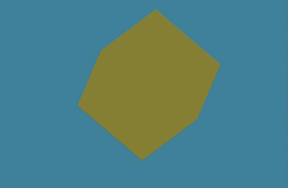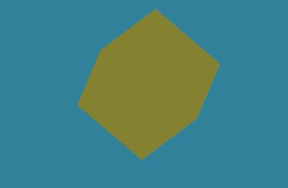
タッチしたところにキューブを動かすようなiPhoneアプリのサンプルコードを描いてみます。
動かすとこんな感じです
サンプルコード
#import <GLKit/GLKit.h>
@interface ViewController : GLKViewController
@end
#import “ViewController.h”
static const GLfloat cubeVertices[] = {
–1.0, –1.0, 1.0,
1.0, –1.0, 1.0,
–1.0, 1.0, 1.0,
1.0, 1.0, 1.0,
–1.0, –1.0, –1.0,
1.0, –1.0, –1.0,
–1.0, 1.0, –1.0,
1.0, 1.0, –1.0,
};
static const GLushort cubeIndices[] = {
0, 1, 2, 3, 7, 1, 5, 4, 7, 6, 2, 4, 0, 1
};
@interface ViewController () {
GLuint v;
GLuint index;
GLfloat degree;
CGPoint touche;
CGPoint cubePosition;
}
@property (nonatomic, strong) GLKBaseEffect *baseEffect;
@property (nonatomic, strong) GLKView *gv;
@end
@implementation ViewController
– (void)loadView
{
self.view = [[GLKView alloc] initWithFrame:CGRectMake(0, 0, 320, 568) context:[[EAGLContext alloc] initWithAPI:kEAGLRenderingAPIOpenGLES3]];
}
– (void)viewDidLoad
{
[super viewDidLoad];
self.gv = (GLKView*)self.view;
self.gv.drawableColorFormat = GLKViewDrawableDepthFormat16;
[EAGLContext setCurrentContext:self.gv.context];
self.baseEffect = [[GLKBaseEffect alloc] init];
self.baseEffect.useConstantColor = YES;
self.baseEffect.constantColor = GLKVector4Make(0.5f, 0.5f, 0.2f, 1.0f);
glClearColor(0.2f, 0.5f, 0.6f, 1.0f);
glGenBuffers(1, &v);
glBindBuffer(GL_ARRAY_BUFFER, v);
glBufferData(GL_ARRAY_BUFFER, sizeof(cubeVertices), cubeVertices, GL_STATIC_DRAW);
glGenBuffers(1, &index);
glBindBuffer(GL_ELEMENT_ARRAY_BUFFER, index);
glBufferData(GL_ELEMENT_ARRAY_BUFFER, sizeof(cubeIndices), cubeIndices, GL_STATIC_DRAW);
glEnable(GL_DEPTH_TEST);
glEnable(GL_BLEND);
glEnable(GL_CULL_FACE);
}
– (void)glkView:(GLKView *)view drawInRect:(CGRect)rect
{
[self.baseEffect prepareToDraw];
glClear(GL_COLOR_BUFFER_BIT | GL_DEPTH_BUFFER_BIT);
const GLfloat aspectRatio = (GLfloat)view.drawableWidth / (GLfloat)view.drawableHeight;
self.baseEffect.transform.projectionMatrix = GLKMatrix4MakeScale(0.3, 0.3 * aspectRatio, 0.1);
glBindBuffer(GL_ELEMENT_ARRAY_BUFFER, v);
glVertexAttribPointer(GLKVertexAttribPosition, 3, GL_FLOAT, GL_FALSE, 3 * sizeof(GLfloat), NULL + 0);
glEnableVertexAttribArray(GLKVertexAttribPosition);
glBindBuffer(GL_ELEMENT_ARRAY_BUFFER, index);
glDrawElements(GL_TRIANGLE_STRIP, 14, GL_UNSIGNED_SHORT, 0);
GLKMatrix4 modelViewMatrix = GLKMatrix4Identity;
if (!CGPointEqualToPoint(touche, cubePosition)) {
float dx = (touche.x – 160.0) – cubePosition.x;
float dy = (touche.y – 264) – cubePosition.y;
float u = hypot(dx, dy) * 10.0;
cubePosition = CGPointMake(cubePosition.x + dx/u, cubePosition.y – dy/u);
modelViewMatrix = GLKMatrix4Translate(modelViewMatrix, cubePosition.x * 0.3, cubePosition.y * 0.3 * aspectRatio, 0);
}
modelViewMatrix = GLKMatrix4Rotate(modelViewMatrix, GLKMathDegreesToRadians(degree), 1, 0, 1);
self.baseEffect.transform.modelviewMatrix = modelViewMatrix;
degree++;
}
– (void)touchesBegan:(NSSet *)touches withEvent:(UIEvent *)event
{
touche = [[touches anyObject] locationInView:self.view];
}
– (void)didReceiveMemoryWarning
{
[super didReceiveMemoryWarning];
// Dispose of any resources that can be recreated.
}
@end
